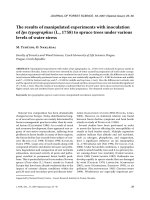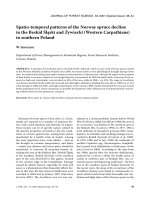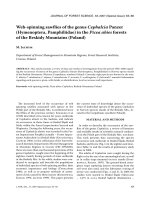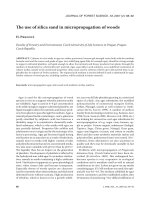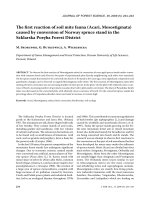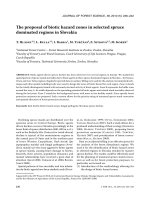Báo cáo lâm nghiệp: "The first reaction of soil mite fauna (Acari, Mesostigmata) caused by conversion of Norway spruce stand in the Szklarska Poręba For" potx
Bạn đang xem bản rút gọn của tài liệu. Xem và tải ngay bản đầy đủ của tài liệu tại đây (238.5 KB, 10 trang )
234 J. FOR. SCI., 55, 2009 (5): 234–243
JOURNAL OF FOREST SCIENCE, 55, 2009 (5): 234–243
e Szklarska Poręba Forest District is located
partly in the Karkonosze and Izera Mts. (Poland,
SW). e mountains are old, doom-shaped with soils
of low fertility. ey consist mainly of acid rocks,
including granite and sandstone, with low volume
of calcium carbonate. e calcareous formations are
to be found only as small lenses of limestone. Acid
rock, such as granite and porphyry, form a basis for
the poorest soils (Z 1986).
In the last 150 years, the species composition of the
mountains forest stands has undergone significant
changes. Due to economic reasons, natural stands
were converted into artificial, monocultures of Nor-
way spruce (Picea abies [L.] H. Karst.) stand with
minor share of silver fir (Abies alba Mill.), common
beech (Fagus sylvatica L.) and sycamore maple (Acer
pseudoplatanus L.) (Z 1986). e creation of
a large area of spruce monocultures, coupled with
huge increase of air pollution caused by German,
Czech and Polish power plants and industrial facili-
ties, led to an ecological disaster throughout 1970s
and 1980s. is contributed to numerous gradations
of bark beetles (Ips typhographus [L.]) and damage
caused by windfalls and snowbreaks (K et al.
1997). Today the spruce stands growing on the fer-
tile sites (mountain forest site or mixed mountain
forest site, dedicated mainly for broadleaves and fir)
are being converted into beech and fir stands. e
research was an attempt to observe first reactions to
the conversion on the part of soil mesofauna that has
been developed for many years under the influence
of spruce stands. Mites (Acari) are divided into four
main orders: Astigmata, Prostigmata, Oribatida and
Mesostigmata. Mites from the order Mesostigmata
are usually bigger than Astigmata and Prostigmata
mites. e Oribatida mites (more similar in size
to Mesostigmata mites) are the most common
soil-inhabiting mites and saprophagous animals.
Mesostigmata mites are mainly free-living preda-
tors (suborder Gamasina, with the most numerous
families: Parasitidae, Veigaiaidae, Rhodacaridae,
Zerconidae and Laelapidae) which are feeding on
e first reaction of soil mite fauna (Acari, Mesostigmata)
caused by conversion of Norway spruce stand in the
Szklarska Poręba Forest District
M. S, G. B, A. W
Department of Game Management and Forest Protection, Poznan University of Life Sciences,
Poznań, Poland
ABSTRACT: To observe the rst reaction of Mesostigmata mites for conversion of even aged spruce stands under conver-
sion with common beech and silver r, four pairs of experimental plots directly neighbouring each other were examined.
On the spruce stands that started to be converted into beech or r stands a few years ago, some signicant composition and
quantitative changes can be observed as regards Mesostigmata order mites. e rst reaction of Mesostigmata mites aer
starting of forest conversion was an increasing number of mite species in the plots. On the plots with relatively close occur-
rence of beech, increasing number of specimens was also observed in plots under conversion. e share of Parasitidae family
mites was decreased on the converted plots with relatively close occurrence of beech. On the converted spruce stands the
percentage share of Uropodina suborder mites was found to increase or remain high.
Keywords: Acari; Mesostigmata; mites; forest conversion; biodiversity; soil ecology
J. FOR. SCI., 55, 2009 (5): 234–243 235
wide range of invertebrates (i.e. nematodes, other
mites, springtails) or fungivorous animals (mainly
from suborder Uropodina). Different species com-
position of Mesostigmata mites depending on dif-
ferent tree species stands was found in “common
garden” forest experiment with fourteen tree species
(S et al. 2003b).ese animals have low
tolerance to changes in soil environment so they are
good bioindicators. Because of narrow ecological
range their presence or absence in soil can be good
base for describing environmental conditions and
attitudes (P 1999).
MATERIAL AND METHODS
Field research was carried out in May and No-
vember 2005. To observe the first reaction for con-
version, four pairs of experimental plots directly
neighbouring each other were examined. A list of the
experimental plots is in Table 1. Plots 1, 2, 3 and 4
were situated in relatively close distance to the stands
with occurrence of beech (less than 100 m) and plots
7 and 8 were located in pure spruce stands without
any amount of beech in distance over 200 m.
Plots 5 and 6 were chosen to compare species
composition of Mesostigmata mites in natural re-
generation of beech growing in open area and under
thinned spruce and beech canopy.
Twenty soil samples were taken from each of eight
plots, with 10 samples taken in spring and 10 in au-
tumn. Each sample covered an area of 40 cm
2
with
organic layer and mineral soil to the depth of 5 cm.
On the plots under conversion the samples were
taken at a distance of ca 50 cm from young trees,
and in the old stands the samples were taken under
canopy. e material was extracted in Tullgren fun-
nels (using light and heat to dry a sample).
e analysis of the results was conducted with the
aid of the AnalizaTOR 2.0 program, using typical
rates: the similarity rates for the domination rates of
species between microhabitats (Mo):
Mo = 2Σxiyi/(Σxa2 + Σya2)
where:
xiyi
– percentage amount of number of species common
for both microhabitats,
xa, ya – percentage amount of particular species,
i
– total number of species;
domination rate (D):
D = (100s/S)
where:
s – number of specimens of species,
S – number of specimens of all species in this cenotic unit;
a cluster analyze of similarity rates for the domina-
tion rates of mite species between experimental
plots; occurrence rate (C):
C = 100 q/Q
where:
q – denotes the number of samples, in which the given spe-
cies was found,
Q – denotes the number of examined species (O
1982).
In occurrence stability index following classes
were taken: euconstants – 75% and more samples,
constants – 50–74% samples, accessory species –
25–49% samples, accidents – 24% and less samples.
In domination rate following classes were taken:
eudominants – more than 10% specimens, domi-
nants – 5.1–10%, subdominants – 2.1–5.0%, rece-
dents – 1.1–2.0%, subrecedents – less than 1.1%
(N et al. 1981). e domination rates of
Uropodina suborder and Parasitidae family mites
were also analyzed; this selection was based on the
Table 1. A list of experimental plots (Plan Urządzenia lasu … 1994)
Plot
Forest
compartment
Tree stand Forest site
1 169b pure stand of 111-year-old spruce mixed mountain forest site
2 169b 4-year-old beech stand in a thinned 111-year-old stand mixed mountain forest site
3 169g pure stand of 38-year-old spruce mixed mountain forest site
4 169b cluster of 8-year-old fir under a 112-year-old spruce stand mixed mountain forest site
5 280d stand of 10-year-old beech mountain forest site
6 179k
thinned stand of dominant 116-year-old spruce mixed with beech
and a natural regeneration of 8-year-old beech
mountain forest site
7 310c pure stand of 86-year-old spruce mixed mountain forest site
8 310b cluster of 8-year-old fir under a 97-year-old spruce stand mixed mountain forest site
236 J. FOR. SCI., 55, 2009 (5): 234–243
Table 2. Species composition of Mesostigmata mites on a pair of experimental plots: plot 1 (spruce) and plot 2 (spruce
with beech); number of specimens (No.), domination (D) and occurrence (C) rates are presented
Species on the plot 1 No. C D Species on the plot 2 No. C D
Veigaia nemorensis 78 65.00 29.77 Veigaia nemorensis 130 100.00 25.54
Trachytes aegrota 38 45.00 14.50 Trachytes aegrota 102 75.00 20.04
Gamasellus montanus 29 55.00 11.07 Polyaspinus cylindricus 63 55.00 12.38
Leptogamasus cristulifer 25 55.00 9.54 Pachylaelaps bellicosus 39 45.00 7.66
Hypoaspis aculeifer 23 45.00 8.78 Hypoaspis aculeifer 20 40.00 3.93
Polyaspinus cylindricus 17 25.00 6.49 Leptogamasus obesus 15 45.00 2.95
Leptogamasus obesus 10 30.00 3.82 Gamasellus montanus 14 30.00 2.75
Parazercon radiatus 9 30.00 3.44 Trachytes pauperior 14 35.00 2.75
Paragamasus crassicornutus 5 20.00 1.91 Paragamasus crassicornutus 13 45.00 2.55
Uropoda misella 5 10.00 1.91 Parazercon radiatus 12 35.00 2.36
Vulgarogamasus kraepelini 4 15.00 1.53 Hypoaspis procera 12 10.00 2.36
Hypoaspis procera 3 10.00 1.15 Leptogamasus cristulifer 11 10.00 2.16
Pergamasus crassipes 3 10.00 1.15 Leptogamasus sp. 7 10.00 1.38
Pachylaelaps longisetis 3 15.00 1.15 Urodiaspis tecta 7 25.00 1.38
Urodiaspis tecta 2 10.00 0.76 Pachylaelaps furcifer 6 15.00 1.18
Holoparasitus hemisphaericus 1 5.00 0.38 Pachylaelaps longisetis 6 25.00 1.18
Geholaspis mandibularis 1 5.00 0.38 Pergamasus crassipes 5 25.00 0.98
Lasioseius lawrencei 1 5.00 0.38 Pergamasus ruehmi 5 25.00 0.98
Gamasina sp. 1 5.00 0.38 Veigaia kochi 4 20.00 0.79
Veigaia exigua 1 5.00 0.38 Macrocheles opacus 4 10.00 0.79
Eviphis ostrinus 1 5.00 0.38 Holoparasitus hemisphaericus 3 10.00 0.59
Hypoaspis praesternalis 1 5.00 0.38 Geholaspis longispinosus 3 10.00 0.59
Trachytes pauperior 1 5.00 0.38 Uropoda misella 2 10.00 0.39
Geholaspis mandibularis 2 5.00 0.39
Pachylaelaps sp. 2 10.00 0.39
Paragamasus sp. 2 5.00 0.39
Pergamasus barbarus 1 5.00 0.20
Paragamasus holzmannae 1 5.00 0.20
Vulgarogamasus kraepelini 1 5.00 0.20
Veigaia cervus 1 5.00 0.20
Macrocheles terreus 1 5.00 0.20
Hypoaspis lasiomyrmecophilus 1 5.00 0.20
Sum 262 – 100.00 Sum 509 – 100.00
specific relations between these groups in conifer-
ous, deciduous and mixed forest stands (S
et al. 2003a,b; S 2007). e species names
and mites taxonomy was taken from B and
M (1997) and W (1997).
RESULTS AND DISCUSSION
From all the plots 2,822 mites specimens of 57 spe-
cies were found. e eudominant species include
Veigaia nemorensis (C. L. Koch 1839), while the
J. FOR. SCI., 55, 2009 (5): 234–243 237
Table 3. Species composition of Mesostigmata mites on a pair of experimental plots: plot 3 (spruce) and plot 4 (spruce
with fir); number of specimens (No.), domination (D) and occurrence (C) rates are presented
Species on the plot 3 No. C D Species on the plot 4 No. C D
Veigaia nemorensis 114 70.00 33.14 Veigaia nemorensis 149 95.00 29.68
Leptogamasus obesus 48 65.00 13.95 Trachytes montana 104 90.00 20.72
Gamasellus montanus 46 60.00 13.37 Trachytes aegrota 34 45.00 6.77
Polyaspinus cylindricus 35 35.00 10.17 Leptogamasus obesus 31 65.00 6.18
Pachylaelaps longisetis 14 30.00 4.07 Zercon gurensis 22 40.00 4.38
Trachytes aegrota 11 25.00 3.20 Pachylaelaps bellicosus 20 30.00 3.98
Paragamasus crassicornutus 11 35.00 3.20 Paragamasus crassicornutus 16 45.00 3.19
Zercon gurensis 10 20.00 2.91 Polyaspinus cylindricus 14 25.00 2.79
Uropoda misella 8 15.00 2.33 Paragamasus vagabundus 13 30.00 2.59
Trachytes pauperior 8 20.00 2.33 Gamasellus montanus 10 35.00 1.99
Geholaspis pauperior 7 15.00 2.03 Heteroparasitus tirolensis 7 20.00 1.39
Veigaia cervus 4 20.00 1.16 Prozercon fimbriatus 5 5.00 1.00
Pachylaelaps furcifer 3 15.00 0.87 Uropoda misella 5 15.00 1.00
Pergamasus ruehmi 3 15.00 0.87 Urodiaspis tecta 5 15.00 1.00
Pachylaelaps sp. 3 15.00 0.87 Prozercon kochi 5 25.00 1.00
Vulgarogamasus kraepelini 3 15.00 0.87 Eviphis ostrinus 5 15.00 1.00
Parazercon radiatus 2 10.00 0.58 Trachytes pauperior 5 20.00 1.00
Geholaspis mandibularis 2 5.00 0.58 Veigaia cervus 5 20.00 1.00
Prozercon kochi 2 10.00 0.58 Pachylaelaps furcifer 4 15.00 0.80
Pergamasus sp. 2 5.00 0.58 Pergamasus ruehmi 4 15.00 0.80
Leptogamasus cristulifer 1 5.00 0.29 Parasitidae sp. 4 15.00 0.80
Pergamasus crassipes 1 5.00 0.29 Paragamasus sp. 4 10.00 0.80
Pergamasus barbarus 1 5.00 0.29 Parazercon radiatus 3 15.00 0.60
Gamasina sp. 1 5.00 0.29 Geholaspis pauperior 3 10.00 0.60
Paragamasus homopodoides 1 5.00 0.29 Vulgarogamasus kraepelini 3 15.00 0.60
Ameroseius sp. 1 5.00 0.29 Geholaspis longispinosus 3 15.00 0.60
Pergamasus mediocris 1 5.00 0.29 Geholaspis mandibularis 2 10.00 0.40
Macrocheles opacus 1 5.00 0.29 Eugamasus cavernicola 2 5.00 0.40
Epicrius resinae 2 5.00 0.40
Hypoaspis aculeifer 1 5.00 0.20
Leptogamasus suecicus 1 5.00 0.20
Dendrolaelaps sp. 1 5.00 0.20
Pachylaelaps longisetis 1 5.00 0.20
Pergamasus barbarus 1 5.00 0.20
Paragamasus holzmannae 1 5.00 0.20
Veigaia kochi 1 5.00 0.20
Veigaia mollis 1 5.00 0.20
Pergamasus sp. 1 5.00 0.20
Paragamasus rostriforceps 1 5.00 0.20
Dermanyssus gallinae 1 5.00 0.20
Macrocheles opacus 1 5.00 0.20
Gamasellodes bicolor 1 5.00 0.20
Sum 344 – 100.0 Sum 502 – 100.0
238 J. FOR. SCI., 55, 2009 (5): 234–243
Table 4. Species composition of Mesostigmata mites on a pair of experimental plots: plot 5 (young beech) and plot 6
(spruce with beech); number of specimens (No.), domination (D) and occurrence (C) rates are presented
Species on the plot 5 No. C D Species on the plot 6 No. C D
Veigaia nemorensis 77 65.00 41.62 Veigaia nemorensis 102 85.00 33.44
Hypoaspis aculeifer 16 30.00 8.65 Pachylaelaps bellicosus 36 55.00 11.80
Trachytes montana 15 30.00 8.11 Leptogamasus obesus 25 30.00 8.20
Leptogamasus obesus 13 30.00 7.03 Hypoaspis aculeifer 17 10.00 5.57
Trachytes pauperior 10 30.00 5.41 Zercon gurensis 13 30.00 4.26
Polyaspinus cylindricus 9 35.00 4.86 Trachytes montana 12 40.00 3.93
Trachytes aegrota 8 20.00 4.32 Gamasellus montanus 11 20.00 3.61
Pergamasus ruehmi 5 20.00 2.70 Parazercon radiatus 11 30.00 3.61
Uropoda misella 4 10.00 2.16 Trachytes aegrota 10 30.00 3.28
Vulgarogamasus kraepelini 4 20.00 2.16 Pachylaelaps longisetis 9 30.00 2.95
Parazercon radiatus 3 10.00 1.62 Pergamasus ruehmi 9 30.00 2.95
Leptogamasus cristulifer 3 5.00 1.62 Pachylaelaps ineptus 8 10.00 2.62
Veigaia mollis 3 10.00 1.62 Pachylaelaps furcifer 5 10.00 1.64
Veigaia exigua 3 15.00 1.62 Vulgarogamasus kraepelini 5 20.00 1.64
Gamasellus montanus 2 5.00 1.08 Paragamasus crassicornutus 4 20.00 1.31
Paragamasus crassicornutus 2 10.00 1.08 Uropoda misella 4 10.00 1.31
Geholaspis longispinosus 2 5.00 1.08 Veigaia exigua 4 5.00 1.31
Pachylaelaps furcifer 1 5.00 0.54 Veigaia cervus 4 15.00 1.31
Pachylaelaps longisetis 1 5.00 0.54 Uropoda minima 3 5.00 0.98
Urodiaspis tecta 1 5.00 0.54 Geholaspis mandibularis 2 10.00 0.66
Pergamasus barbarus 1 5.00 0.54 Trachytes pauperior 2 5.00 0.66
Zercon gurensis 1 5.00 0.54 Geholaspis longispinosus 2 5.00 0.66
Veigaia cervus 1 5.00 0.54 Polyaspinus cylindricus 1 5.00 0.33
Leptogamasus cristulifer 1 5.00 0.33
Geholaspis pauperior 1 5.00 0.33
Veigaia kochi 1 5.00 0.33
Gamasina sp. 1 5.00 0.33
Paragamasus homopodoides 1 5.00 0.33
Paragamasus sp. 1 5.00 0.33
Sum 185 – 100.00 Sum 305 – 100.00
dominant species include Trachytes montana Will-
mann 1953, T. aegrota (C. L. Koch 1841), Leptogama-
sus obesus (Holzmann, 1955), Gamasellus montanus
(Willmann, 1936), Pachylaelaps bellicosus Berlese,
1920 and Polyaspinus cylindricus Berlese, 1916. ere
were 20.16% mites from suborder Uropodina, while
23.18% from Parasitidae family. Species composition
on pairs of experimental plots, number of specimens,
domination and occurrence rate are shown in Tables
2 to 5. Average number of Mesostigmata mites is
4,409 per m
2
, and average number of species is 27 per
plot. In other researches in surrounding mountain
areas the number of collected specimens per m
2
of
Mesostigmata mites was similar: in spruce stands
in Karkonosze Mountains – 3,085 (G
2003) and in Izera Mountains – 3,883 (S
2005), in mixed spruce-beech stands in Karkonosze
Mts. – 4,507 (G 2003), in different tree
J. FOR. SCI., 55, 2009 (5): 234–243 239
Table 5. Species composition of Mesostigmata mites on a pair of experimental plots: plot 7 (spruce) and plot 8 (spruce
with fir); number of specimens (No.), domination (D) and occurrence (C) rates are presented
Species on the plot 7 No. C D Species on the plot 8 No. C D
Trachytes montana 82 80.00 20.55 Pachylaelaps bellicosus 62 70.00 19.62
Gamasellus montanus 78 70.00 19.55 Veigaia nemorensis 55 75.00 17.41
Veigaia nemorensis 54 70.00 13.53 Paragamasus vagabundus 48 60.00 15.19
Parazercon radiatus 49 65.00 12.28 Trachytes montana 40 65.00 12.66
Leptogamasus obesus 44 75.00 11.03 Leptogamasus obesus 13 45.00 4.11
Paragamasus vagabundus 12 30.00 3.01 Parazercon radiatus 10 5.00 3.16
Polyaspinus cylindricus 11 20.00 2.76 Hypoaspis aculeifer 9 25.00 2.85
Pachylaelaps longisetis 11 30.00 2.76 Geholaspis pauperior 9 5.00 2.85
Paragamasus crassicornutus 9 25.00 2.26 Polyaspinus cylindricus 8 15.00 2.53
Trachytes pauperior 9 25.00 2.26 Pachylaelaps longisetis 7 25.00 2.22
Pachylaelaps bellicosus 8 10.00 2.01 Veigaia cervus 7 20.00 2.22
Trachytes aegrota 7 15.00 1.75 Trachytes aegrota 6 15.00 1.90
Pachylaelaps furcifer 7 30.00 1.75 Gamasellus montanus 6 25.00 1.90
Pergamasus ruehmi 5 15.00 1.25 Veigaia mollis 6 20.00 1.90
Veigaia kochi 2 5.00 0.50 Leptogamasus suecicus 3 15.00 0.95
Vulgarogamasus kraepelini 2 10.00 0.50 Arctoseius brevicheles 3 5.00 0.95
Veigaia cervus 2 10.00 0.50 Trachytes pauperior 3 15.00 0.95
Geholaspis pauperior 1 5.00 0.25 Paragamasus crassicornutus 2 10.00 0.63
Pergamasus crassipes 1 5.00 0.25 Hypoaspis procera 2 10.00 0.63
Amblyseius sp. 1 5.00 0.25 Pergamasus crassipes 2 5.00 0.63
Veigaia exigua 1 5.00 0.25 Paragamasus holzmannae 2 10.00 0.63
Trichouropoda sp. 1 5.00 0.25 Prozercon kochi 2 5.00 0.63
Parasitidae sp. 1 5.00 0.25 Eviphis ostrinus 2 10.00 0.63
Paragamasus sp. 1 5.00 0.25 Vulgarogamasus kraepelini 2 10.00 0.63
Uropoda misella 1 5.00 0.32
Amblyseius sp. 1 5.00 0.32
Pergamasus ruehmi 1 5.00 0.32
Veigaia kochi 1 5.00 0.32
Pergamasus sp. 1 5.00 0.32
Gamasellodes bicolor 1 5.00 0.32
Epicriopsis horridus 1 5.00 0.32
Sum 399 – 100.00 Sum 316 – 100.00
stands in Izera River Valley – 6,196 (S et
al. 2008). e number of identified species is higher
than in the studies on neighbouring mountain areas
(G, B 2000; G
2002, 2003; S 2005; S et al. 2005),
where under the similar conditions only 42–46 spe-
cies were identified in the area between the Czech
Izera Mts. and the Karkonosze Mts. and 53 species
in Izera River Valley (S et al. 2008).
e first reaction of Mesostigmata mites, only a
few years after starting of forest conversion was in-
creasing number of species in the plots (Table 6). On
240 J. FOR. SCI., 55, 2009 (5): 234–243
the plots with relatively close occurrence of beech,
increasing number of specimens was also observed
in plots under conversion, while in the plots located
in surrounding pure spruce stands the number of
specimens was lower (Table 7). Each experimental
plot was characterized by different species com-
position. Comparing the species composition with
similarity rates (Table 8) the highest rates (over 68)
had two pairs of experimental plots: 1 and 2 and
5 and 6 and the other pairs 3 and 4 and 7 and 8 still
had a similarity rates quite high and over 50. e
lowest rates (less than 40) were among plots 2 and 7,
1 and 8 and 3 and 8 (every three pairs are with plots
located in different places and with different struc-
ture – stands non-converted and during conversion).
When we compared pairs of plots with similar stand
structure, the similarity rates were higher (usually
over 50). e cluster analyze of similarity rates for
the domination rates of mite species between ex-
perimental plots presented high similarity between
plots in every pairs (Fig. 1). In addition, the pair of
plots 7 and 8 which are located in pure spruce stands
without any amount of beech in distance over 200 m
had the lowest similarity rates to the other plots,
which are in the stands with occurrence of beech.
e dendrogram shows that any re-naturalization
of soil fauna is based on previous species composi-
tion and that mite species composition in large sur-
face monoculture spruce stands is different than in
spruce stands with close distance to mixed forests.
Table 6. Number of Mesostigmata mites species found on the plots with stands non conversed (1, 3 and 7) and with
stands during conversion (2, 4 and 8)
Stands non conversed No. of species Stands during conversion No. of species
Plot 1 22 plot 2 29
Plot 3 25 plot 4 39
Plot 7 22 plot 8 30
Table 7. Average density of Mesostigmata mites/m
2
found in experimental plots with stands non conversed (1, 3 and 7)
and with stands during conversion (2, 4 and 8)
Stands non conversed Average density (m
2
) Stands during conversion Average density (m
2
)
Plot 1 3,275 plot 2 6,363
Plot 3 4,300 plot 4 6,275
Plot 7 4,988 plot 8 3,950
Fig. 1. e dendrogram of similarity rates for the domination rates of mite species between experimental plots (1 to 8 – respec-
tively the numbers of experimental plots)
J. FOR. SCI., 55, 2009 (5): 234–243 241
e increasing number of mite species in stands
during conversion on lowlands was already observed
(S et al. 2003a,b).
Comparing domination rates of mites from Uro-
podina suborder and Parasitidae family (Table 9)
on the pairs of experimental plots with relatively
close occurrence of beech we can observe that
on the converted plots the domination of Uropo-
dina mites was increased and domination rate of
Parasitidae mites was decreased. Similar results
of the reaction of this group of mites to increas-
ing amount of broadleaves in tree-stands were
presented in “common-garden” forest experiment
(S 2007). The reaction to conversion of
selected mite species is presented in Table 10. The
strongest reaction is of Gamasellus montanus,
which has high domination rates in spruce forests,
and very low in plots under conversion or with
young generation of beech.
CONCLUSIONS
(1) On the spruce stands that started to be converted
into beech or fir stands in the course of just a
few years some significant composition and
quantitative changes can be observed as regards
Mesostigmata order mites.
(2) e first reaction of Mesostigmata mites after
starting of forest conversion was increasing
number of species in the plots. On the plots with
relatively close occurrence of beech, increasing
number of specimens was also observed in plots
under conversion.
(3)
Gamasellus montanus quickly decreased in
number on the converted plots with beech or
fir, which follows from its lower share in mixed
spruce-beech stands.
(4) e share of Parasitidae family mites was de
-
creased on the converted plots with relatively
close occurrence of beech.
(5) On the converted spruce stands the percentage
share of Uropodina suborder mites was found to
increase or remain high.
Table 8. e similarity rates for the domination rates of Mesostigmata mites species between experimental plots
Plots 4 2 1 8 7 6 3
5 60.788 53.927 62.103 45.160 42.804 68.133 59.952
4 54.106 51.442 54.938 58.952 62.638 58.088
2 68.346 45.129 37.364 56.859 55.627
1 38.314 40.808 56.914 62.403
8 50.845 54.122 37.880
7 46.668 53.545
6 63.753
Table 9. Domination rate of mites from Uropodina
suborder and Parasitidae family on experimental plots
Plot Uropodina Parasitidae
1 24.05 18.32
2 36.94 12.57
3 18.02 20.93
4 33.27 17.73
5 25.41 15.14
6 10.49 15.08
7 27.57 18.8
8 18.35 23.42
Average 24.26 17.75
Table 10. e example of Mesostigmata mites species
which increased or decreased domination rates on the
plots under conversion on the pairs plots with relatively
close occurrence of beech
Species Plot 1 Plot 2 Plot 3 Plot 4
Gamasellus montanus 11.07 2.75 13.37 1.99
Leptogamasus cristulifer 9.54 2.16 0.29 0.00
Veigaia nemorensis 29.77 25.54 33.14 29.68
Pachylaelaps bellicosus 0.00 7.66 0.00 3.98
Trachytes aegrota 14.50 20.04 3.20 6.77
242 J. FOR. SCI., 55, 2009 (5): 234–243
R e fe re nce s
BŁASZAK C., MADEJ G., 1997.
Gamasida: Antennophorina,
Microgyniina, Sejina, Gamasina. In: RAZOWSKI J. (ed.),
Wykaz Zwierząt Polski. Kraków, Instytut Systematyki
i Ewolucji Zwierząt PAN,
4: 190202.
GWIAZDOWICZ D.J., 2002.
e effect of ski runs on the
fauna of mites (Acari, Gamasida) in the Karkonosze Moun-
tains. Scientific Papers of the Agricultural University of
Poznań, Forestry, 5: 2129.
GWIAZDOWICZ D.J., 2003.
Mites (Acari, Gamasida) of
the tree stands in lower and upper subalpine forests in the
Karkonosze National Park. Acta Scientiarum Polonorum,
Silvarum Colendarum Ratio et Industria Lignaria, Poznań,
2: 518.
GWIAZDOWICZ D.J., BIERNACIK R., 2000.
Roztocze
(Acari, Gamasida) wybranych mikrośrodowisk Karkonos-
kiego Parku Narodowego. Opera Corcontica, 37: 200210.
KONCA B., MICHALSKI J., ZIMNY J
., 1997. Problemy
ochrony lasu w Sudetach ze szczególnym uwzględnieniem
Karkonoszy polskich. Geologiczne problemy Karkonoszy.
Materiały z III Konferencji Naukowej 15–18 października
w Przesiece: 255–262.
NIEDBAŁA W., BŁASZAK C., BŁOSZYK J., KALISZEWSKI
M., KAZMIERSKI A., 1981.
Roztocze (Acari). Fragmenta
Faunistica, An International Journal of Faunology, Warsaw
,
26: 105156.
ODUM E., 1982.
Podstawy ekologii. Wydanie II. Warszawa,
Państwowe Wydawnictwo Rolnicze i Leśne: 661.
PLAN URZĄDZENIA LASU DLA NADLEŚNICTWA
SZKLARSKA PORĘBA NA LATA
1994–2004, 1994. Biuro
Urządzania Lasu i Geodezji Leśnej, Brzeg.
PRUSINKIEWICZ Z., 1999. Środowisko i gleby w definicjach.
Toruń, Oficyna Wydawnicza Turpress, 38: 282.
SKORUPSKI M., 2005.
Analýza početnosti půdních roztočů
(Řád Mesostigmata) na vápněných i nevápněných lokalitách
v zájmovém území Jizerských hor. In: SLODIČÁK M.,
NOVÁK J. (eds), Lesnické hospodaření v Jizerských horách.
Hradec Králové, Lesy České republiky, Jíloviště-Strnady,
VÚLHM: 8993.
SKORUPSKI
M., 2007. Influence of species composition of
tree stands for soil inhabiting mites from the family Para-
sitidae and suborder Uropodina (Acari: Mesostigmata). In:
MORALESMALACARA J.B., BEHANPELLETIER V.,
UECKERMANN E., PÉREZ T.M., ESTRADAVENE
GAS E.G., BADII
M. (eds), Acarology XI: Proceedings
of the International Congress. Instituto de Biología and
Facultad de Ciencias, Universidad Nacional Autónoma de
México. México, Sociedad Latinoamericana de Acarología:
193–196.
SKORUPSKI M., RADZIKOWSKI A., CEITEL J
., 2003a.
Mites (Acari: Mesostigmata) in experimental oak tree
stands at the Siemianice forest experimental station. Acta
Scientiarum Polonorum, Silvarum Colendarum Ratio et
Industria Lignaria, Poznań, 2: 91–97.
SKORUPSKI M., SZULIŃSKI T., ŻÓŁTOWSKI P., CEITEL J.,
2003b. Species composition of mites (Acari, Mesostigmata)
in forest experimental surfaces of various tree species.
Scientific Papers of the Agricultural University of Poznań,
Forestry, 6: 5766.
SKORUPSKI M., WIERZBICKA A., KAMCZYC J.,
SLODIČÁK M., 2005.
Initial research of Mesostigmata
mites on forest experimental plots in the Jizery Moun
-
tains. Restoration of forest ecosystems of the Jizerské hory
Mts. Prague, Czech University of Life Sciences in Prague,
Jíloviště-Strnady, Forestry and Game Management Research
Institute: 4547.
SKORUPSKI M., BELTER W., KAMCZYC J., WIERZBICKA
A., 2008. Soil mites (Acari, Mesostigmata) of the ‘Torfo-
wiska Doliny Izery’ Reserve in the Sudety Mountains. Soil
Organisms, 80: 261–270.
WIŚNIEWSKI J., 1997.
Uropodina. In: RAZOWSKI J. (ed.),
Wykaz Zwierząt Polski. Kraków, Instytut Systematyki
i Ewolucji Zwierząt PAN,
4: 202205.
ZARĘBA R
., 1986. Puszcze bory i lasy Polski. Warszawa,
Państwowe Wydawnictwo Rolnicze i Leśne: 181–191.
Received for publication September 15, 2008
Accepted after corrections January 20, 2009
První reakce půdní fauny – roztočů (Acari, Mesostigmata) na přeměnu
porostů smrku ztepilého na lesní správě Szklarska Poręba
ABSTRAKT: Pro zjištění první reakce roztočů Mesostigmata na přeměnu stejnověkých smrkových porostů bukem
lesním a jedlí bělokorou byly zkoumány čtyři páry (vzájemně přímo sousedících) výzkumných ploch. Ve smrkových
porostech, kde byla před několika lety zahájena přeměna bukem nebo jedlí, byly zjištěny některé signifikantní změ-
ny v zastoupení a v množství roztočů řádu Mesostigmata. První reakce roztočů Mesostigmata po začátku přeměny
porostů byla charakterizovaná zvýšením počtu druhů roztočů na plochách. Na přeměňovaných plochách s relativně
J. FOR. SCI., 55, 2009 (5): 234–243 243
omezeným výskytem buku byl také zaznamenán nárůst počtu sledovaných jedinců. Podíl roztočů čeledi Parasitidae se
naopak snižoval na sledovaných přeměňovaných plochách s relativně omezeným výskytem buku. V přeměňovaných
smrkových porostech bylo zaznamenáno zvýšení nebo zachování vysokého podílu roztočů podřádu Uropodina.
Klíčová slova: Acari; Mesostigmata; roztoči; přeměna lesa; biodiverzita; půdní ekologie
Corresponding author:
Dr. M S, Poznan University of Life Sciences, Department of Game Management and Forest Protection,
ul. Wojska Polskiego 71d, 60-625 Poznań, Poland
tel.: + 48 618 487 779, fax: + 48 618 487 692, e-mail:

